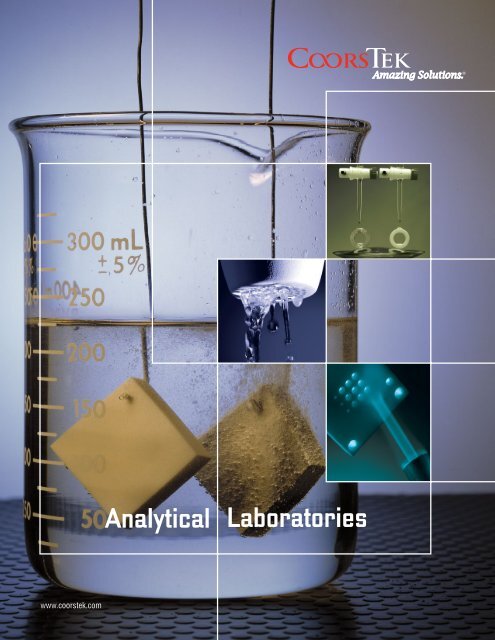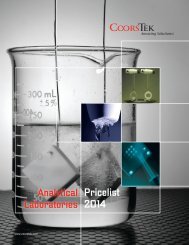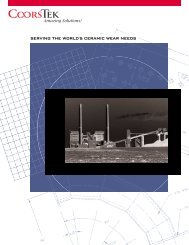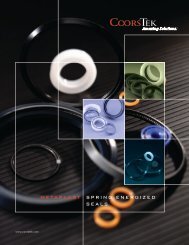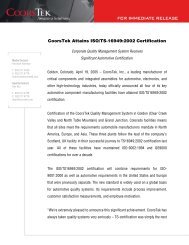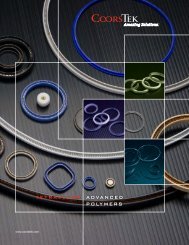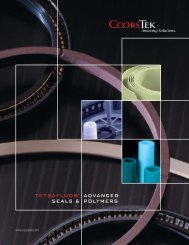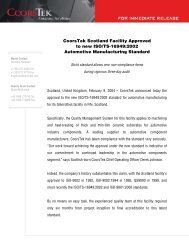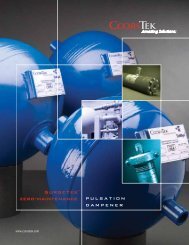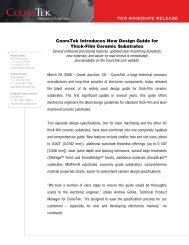Analytical Laboratory Services - CoorsTek
Analytical Laboratory Services - CoorsTek
Analytical Laboratory Services - CoorsTek
You also want an ePaper? Increase the reach of your titles
YUMPU automatically turns print PDFs into web optimized ePapers that Google loves.
www.coorstek.com<br />
<strong>Analytical</strong> Laboratories
Table of Contents<br />
Introduction 3<br />
<strong>Analytical</strong><br />
Laboratories<br />
Mechanical<br />
Testing & SEM<br />
+<br />
Chemical Analysis<br />
+1.303.277.4606<br />
labs@coorstek.com<br />
Thermal Testing 4<br />
DSC Differential Scanning Calorimetry<br />
DTA Differential Thermal Analysis<br />
TGA Thermogravimetric Analysis<br />
Coeffi cient of Thermal Expansion<br />
Thermal Conductivity<br />
Microscopy 5<br />
Physical Testing 6<br />
Mechanical Testing<br />
Micromeritics<br />
Electrical Testing<br />
X-Ray Diffraction 7<br />
X-Ray Fluorescence<br />
Elemental Analysis by Inductively Coupled 8<br />
Plasma–Optical Emission Spectroscopy<br />
Elemental Analysis by Inductively Coupled<br />
Plasma–Mass Spectrometry<br />
Analysis Case File: 9<br />
Laser Ablation – ICP-MS of a Ceramic Material<br />
Additional Facilities<br />
Tests / Samples Sizes<br />
Materials Testing Standards 10<br />
Sample Sizes Charts 11<br />
Custom Testing<br />
Contact Info<br />
Back<br />
<strong>CoorsTek</strong> manufactures critical components<br />
and complete assemblies for semiconductor,<br />
automotive, electronics, medical, telecommunications,<br />
military, and other industrial<br />
applications. Using advanced technical<br />
ceramics and high-performance plastics,<br />
our solutions enable customers’ products<br />
to overcome technological barriers and improve<br />
performance, especially in demanding<br />
or severe service environments.<br />
<strong>CoorsTek</strong> has a highly qualified staff to<br />
assist with material selection and product<br />
design. Please contact us today at<br />
+1.303.271.7000 for more information.<br />
For general information about <strong>CoorsTek</strong>,<br />
visit our website at www.coorstek.com.<br />
For analytical services call us at<br />
+1.303.277.4606.<br />
2
Introduction<br />
The <strong>CoorsTek</strong> <strong>Analytical</strong> Laboratories offer a wide variety of services–from <strong>Analytical</strong> Chemistry to<br />
Material Testing. We employ a staff of trained professionals using the latest techniques and stateof-the-art<br />
analytical instrumentation to provide you with quick and accurate solutions tailored to<br />
your particular needs.<br />
Standard services include:<br />
• X-Ray Fluorescence<br />
• Surface Area Measurements<br />
• X-Ray Diffraction<br />
• Thermal Analysis<br />
• ICP-Optical Emission Spectroscopy • Scanning Electron Microscopy<br />
• ICP-Mass Spectrometry<br />
• Optical Microscopy<br />
• Classical Wet Chemistry<br />
• Custom <strong>Services</strong>: Many tests and analyses<br />
Tek<br />
• Electrical<br />
Brochure<br />
Testing<br />
other than<br />
Icon<br />
those listed are available.<br />
Set<br />
Please<br />
• Mechanical Testing<br />
contact us for fees and techniques on<br />
• Particle Size Distribution<br />
particular requirements.<br />
Quality Assurance:<br />
<strong>CoorsTek</strong> <strong>Analytical</strong> Laboratories are committed to a quality program designed to provide the<br />
highest quality attainable for our customers. This proven quality program assures the highest<br />
probability of confidence both in the precision as well as the accuracy of our analyses.<br />
To ensure that all equipment and instrumentation are functioning at optimum capability, all<br />
analytical instruments are calibrated on a regularly scheduled basis. Calibration data are<br />
traceable to the National Institute of Standards and Technology or other recognized reputable<br />
sources. Complete calibration records are maintained in compliance with government and<br />
military standards.<br />
Safety:<br />
If available, please submit a Material Safety Data Sheet to help with proper handling and disposal.<br />
<strong>Analytical</strong><br />
Laboratories<br />
orsTek <strong>CoorsTek</strong> Brochure Brochure Icon Icon Set Set Icon Icon Set Set<br />
<strong>CoorsTek</strong> Brochure Icon Set<br />
Standard Rush service:<br />
Hazardous<br />
Minimum Samples<br />
service:<br />
material samples:<br />
5 working order: retained:<br />
10 working days (50%<br />
Returned to the<br />
$250.00 90 days<br />
Mechanical<br />
days surcharge)<br />
client for disposition<br />
Testing & SEM<br />
+<br />
Chemical Analysis<br />
white icons white icons<br />
+1.303.277.4606<br />
labs@coorstek.com<br />
white icons<br />
white icons<br />
white<br />
wh<br />
semiconductor thermal mechanical wear fl uid electronic<br />
3
<strong>Analytical</strong><br />
Laboratories<br />
Mechanical<br />
Testing & SEM<br />
+<br />
Chemical Analysis<br />
+1.303.277.4606<br />
labs@coorstek.com<br />
Thermal Testing<br />
Thermal testing capabilities include low- and high-temperature thermal expansion, “green” ceramic<br />
shrinkage, reaction enthalpy, heat capacity, glass transition temperature, reaction kinetics, viscoelastic<br />
properties, loss on drying, loss on ignition filler, content, binder content, softening temperature,<br />
and rheological behavior.<br />
The Thermal Testing <strong>Laboratory</strong> is equipped with an Orton Quartz-Tube Dilatometer for CTE and<br />
Netzsch instruments for TGA/DTA, TC and DSC.<br />
DSC – Differential Scanning Calorimetry<br />
An enthalpy-change method in which the difference in the energy inputs into a substance and a<br />
reference material is measured as a function of temperature, while the substance and the reference<br />
material are subjected to a controlled atmosphere and temperature program. Temperature range:<br />
-180° C to 700° C.<br />
Typical Applications:<br />
• Melting Points<br />
• Glass Transition<br />
• Degree of Cure<br />
• Oxidative Stability<br />
• Heat of Fusion<br />
• Crystallinity<br />
• Specifi c Heat Capacity<br />
• Kinetics<br />
DTA – Differential Thermal Analysis<br />
A temperature-change method in which the temperature difference between a substance and a<br />
reference material is measured as a function of temperature, while the substance and the reference<br />
material are subjected to a controlled atmosphere and temperature program. Temperature range:<br />
-180° C to 1600° C.<br />
Typical Applications:<br />
• Melting points<br />
• Glass Transition<br />
• Degree of Cure<br />
• Oxidative Stability<br />
• Heat of Fusion<br />
• Crystallinity<br />
TGA – Thermogravimetric Analysis<br />
A dynamic-mass change method where the mass of a sample is measured as a function of<br />
temperature while the sample is subjected to a controlled atmosphere and temperature program.<br />
Temperature range: Ambient to 1200° C.<br />
Typical Applications:<br />
• Compositional Analysis<br />
• Thermal Stability<br />
• Reactive Atmosphere Analysis<br />
Coeffi cient of Thermal Expansion<br />
A mechanical characteristic-change method where the length of a sample is measured in a quartz<br />
tube as a function of temperature, while the sample is subjected to a heating profile. Temperature<br />
range: ambient to 1000° C.<br />
Typical Application: Expansion Coefficient<br />
TC Thermal Conductivity<br />
A technique for determining how quickly a sample will conduct heat by applying a short, highintensity<br />
pulse of light to one side of a sample and measuring the increase in temperature as a<br />
function of time on the other side.<br />
4
<strong>Analytical</strong><br />
Laboratories<br />
Microscopy<br />
The Microscopy <strong>Laboratory</strong> performs qualitative measurements by light optical and electron microscopic<br />
techniques and elemental analyses of micro samples by X-ray Spectroscopy.<br />
The laboratory routinely produces thin and polished sections of ceramic material with corresponding<br />
photomicrographic examination for crystal size and related properties, and in the identification<br />
of foreign substances by observation of optical properties. Typical tests performed by the laboratory<br />
are crystal size by linear intercept, thin and polished sections, particle size distribution, and<br />
identifi cation of foreign substances.<br />
Instrumentation includes JEOL 6610 SEM with energy dispersive X-ray Spectroscopy (EDS), Zeiss<br />
Ultrashot 11 and 111B Camera Microscopes, and an Olympus DSX500 digital microscope.<br />
Typical Applications:<br />
• Particle Sizing<br />
• Polished Section<br />
• Photomicrographs<br />
• Optical Microscopy<br />
Mechanical<br />
Testing & SEM<br />
+<br />
Chemical Analysis<br />
+1.303.277.4606<br />
labs@coorstek.com<br />
5
<strong>Analytical</strong><br />
Laboratories<br />
Physical Testing<br />
Mechanical Testing<br />
Various methods are used for mechanical testing. Flexural and compressive strengths are<br />
routinely performed. Fracture toughness can be measured using similar techniques. From these<br />
measurements, Weibull modulus can be determined. Young’s modulus, shear modulus and Poisson’s<br />
ratio can be measured by sonic resonance. Knoop, Vickers, and Rockwell hardness can be<br />
done at various loads.<br />
The Mechanical Testing <strong>Laboratory</strong> is<br />
equipped with Instron strength testers<br />
that can apply forces covering<br />
the range of 10 to 20,000 lbs., and<br />
various polishing machines.<br />
Typical Applications:<br />
• Hardness<br />
• Fracture Mechanics<br />
• Strength<br />
• Dye Penetrant Inspection<br />
Mechanical<br />
Testing & SEM<br />
+<br />
Chemical Analysis<br />
+1.303.277.4606<br />
labs@coorstek.com<br />
Micromeritics<br />
The Micromeritics <strong>Laboratory</strong> is<br />
concerned with the measurement of<br />
surface area, porosity, density, and particle-size distribution of powders.<br />
Surface area is determined by the classical gas adsorption method of Brunauer, Emmet and Teller<br />
(BET). The average particle size distribution is determined by several techniques including sedimentation<br />
and sieve analysis. Porosity and density are measured by suspension and bulk methods.<br />
The laboratory instrumentation includes a Micromeritics-BET Apparatus, a Horiba Laser Scattering<br />
Particle Size Analyzer and certified sieves from 400 mesh to 8 mesh.<br />
Typical Applications:<br />
• Surface area analysis<br />
• Pore size distribution<br />
• Particle Size Distribution<br />
• Density<br />
Electrical Testing<br />
The Electrical Testing <strong>Laboratory</strong> is equipped to perform electrical characterizations of all<br />
types of electrical insulating materials under a variety of conditions and electrical frequencies.<br />
Dielectric strength is determined under oil at 60 Hz ac. Dielectric constant is evaluated at<br />
frequencies up to 2.0 MHz.<br />
Dielectric strength is checked on an instrument capable of applying 150 kvp ac. Dielectric constant<br />
and loss are measured on a QuadTech 7600 RLC meter. Volume and surface resistivities can be<br />
measured in a small furnace coupled to a Hewlett-Packard 4339B high resistivity meter.<br />
Typical Applications:<br />
• Dielectric Constant<br />
• Dissipation Factor<br />
• Loss Index<br />
• Volume Resistivity<br />
• Surface Resistivity<br />
• Dielectric Strength<br />
6
X-Ray Diffraction<br />
X-Ray diffraction is the process of scanning an X-ray beam on the surface of a sample to<br />
reveal the sample’s crystalline structure. This method is non-destructive, allowing for<br />
any sample that is used to be later analyzed with other techniques, or saved for<br />
future investigations. While powders are the preferred sample type, flat bulk samples can<br />
also be used.<br />
Instrumentation includes a Bruker<br />
D8 Discover set up in the Bragg-<br />
Brentano geometry (θ-θ) with parallel<br />
beam capabilities. Sample stages<br />
include an X-Y-Z stage suitable for<br />
micro XRD measurements, a high<br />
temperature stage with vacuum and<br />
controlled atmospheres up to 1400°<br />
C (up to 2300° C for special cases),<br />
and a standard “spinner” stage.<br />
Current beam capabilities are Cu<br />
Kα radiation with a linear LYNXEYE<br />
position sensitive detector.<br />
Whole pattern fitting capabilities are<br />
also possible through the TOPAS<br />
software package.<br />
Typical Applications:<br />
• Qualitative identification of unknowns<br />
• Quantitative determination of free quartz<br />
• Quantitative determination of alpha alumina,<br />
mullite and cristobalite in alumina ceramics<br />
X-Ray Fluorescence<br />
• Quantitative determination of cubic and<br />
monoclinic phases in zirconia<br />
• Quantitative determination of alpha and beta<br />
phases in silicon-nitride<br />
The X-Ray fluorescence technique is method for elemental analysis. Samples are excited with an<br />
X-ray beam and the resulting secondary or fl uorescent X-radiation is measured. Quantitative and<br />
qualitative analyses are provided for elements with atomic numbers from 11 through 92 (sodium<br />
through uranium).<br />
XRF is our method of choice for major oxide chemical analysis of ceramics, refractories, glasses,<br />
geological raw materials, and slags. We are particularly adept at making standards from pure<br />
oxides to match the sample matrix using the fused lithium borate glass disk method. Most oxides<br />
can be analyzed by this method to a detection limit of 0.05% with slightly higher limits for light<br />
elements. In addition we are equipped to prepare pressed pellets and to use whole sample and thin<br />
sample techniques.<br />
Instrumentation includes a computer controlled Phillips MagiX Sequential X-Ray Spectrometer system.<br />
Computer control makes the method particularly useful for multiple samples and quality control work.<br />
Typical Applications:<br />
• Ceramics<br />
• Glasses<br />
• Metals<br />
• Slags<br />
• Refractories<br />
• Geological Materials<br />
<strong>Analytical</strong><br />
Laboratories<br />
Mechanical<br />
Testing & SEM<br />
+<br />
Chemical Analysis<br />
+1.303.277.4606<br />
labs@coorstek.com<br />
7
<strong>Analytical</strong><br />
Laboratories<br />
Mechanical<br />
Testing & SEM<br />
+<br />
Chemical Analysis<br />
+1.303.277.4606<br />
labs@coorstek.com<br />
Elemental Analysis<br />
Inductively Coupled Plasma–Optical Emission Spectroscopy<br />
ICP-OES is a versatile technique for elemental analysis of a wide variety of materials. Concentrations<br />
for most metals and some nonmetals can be determined at major, minor or trace levels using<br />
standard methods. Materials routinely analyzed include ceramics, glass, metals, alloys, aqueous<br />
solutions, pharmaceuticals and pottery glazes.<br />
The laboratory uses a Spectro-Arcos<br />
Inductively Coupled Plasma-Optical<br />
Emission Spectrometer. This instrument<br />
is capable of acquiring the<br />
entire UV-Visible spectrum from 130<br />
to 770 nm.<br />
Typical Applications:<br />
• Ceramics (aluminas,<br />
zirconias, etc.)<br />
• Glass<br />
• Solders<br />
• Electroplating solutions<br />
• Organometallic compounds<br />
(such as magnesium stearate)<br />
• Pottery glazes (for heavy<br />
metal release)<br />
Inductively Coupled Plasma–Mass Spectrometry<br />
ICP-MS is a rapid, multi-element analytical technique capable of determining elemental and<br />
isotopic concentrations to sub ng/ml levels in solution. It combines two proven technologies: an<br />
inductively coupled plasma for ion generation and a quadrupole mass analyzer for the subsequent<br />
separation and detection of these ions. Up to 70 elements can be determined in every scan with<br />
this technique.<br />
The laboratory uses a Varian 820MS Inductively Coupled Plasma-Mass Spectrometer. The<br />
instrument has a Collision Reaction Interface for eliminating the typical interferences generated in<br />
the plasma.<br />
With the Cetac LSX-500 Laser Ablation sampling accessory, direct solid analysis is routine. The<br />
laser can vaporize a contaminated surface without affecting the underlying material of a solid<br />
sample. Sensitivities are generally to the µg/g level. Since there is no sample preparation, there is<br />
less opportunity for contamination.<br />
Typical Applications:<br />
• Isotope ratios<br />
• Aqueous Solutions<br />
• Metals<br />
• Solid surfaces/<br />
contaminated areas<br />
• Ceramics<br />
• Glass<br />
• Micro-electronic<br />
devices<br />
8
Analysis Case File<br />
Laser Ablation–ICP-MS of a Ceramic Material<br />
The Laser Ablation sampling accessory is a powerful tool for elemental analysis when used with<br />
the ICP-MS. For some solid samples a total dissolution is not practical because the distribution of<br />
the elements of concern may be inhomogeneous or because dissolution may introduce contamination.<br />
<strong>CoorsTek</strong> <strong>Analytical</strong> <strong>Laboratory</strong> applies the laser sampling technique when it is the most<br />
appropriate and when a fast, inexpensive qualitative survey is needed.<br />
A sample of ZrSnTiO 4 ceramic was submitted for analysis. The client requested a qualitative elemental<br />
analysis for trace contaminants. We studied the material by LA-ICP-MS and also by SEM/<br />
EDS. The former identified 14 elements to be present in the sample while the latter identified only<br />
four. Since a standard material was not available, an accurate quantitative determination of the elements<br />
could not be made using these techniques. However, since the LA-ICP-MS technique found<br />
many more elements than the SEM/EDS technique, relative sensitivity became of interest.<br />
As a fi rst order approach to quantitative determination, the integrated spectral peak intensities<br />
were compared as though their concentrations were directly proportional to the elemental concentrations.<br />
In the following table the units are in percent of total detected peak intensity:<br />
From the table it is seen that the two techniques<br />
are in reasonable agreement regarding<br />
the concentrations of the major components,<br />
but the estimated detection limit of the SEM/<br />
EDS is only about 1% whereas the LA-ICP-<br />
MS detected impurities down to the parts per<br />
million level.<br />
In addition to sensitivity, LA-ICP-MS has the<br />
advantages of:<br />
• Depth profi ling capability<br />
• No requirement for electrical<br />
conductivity in samples<br />
• Detection of Li, Be and B<br />
SEM/EDS has two advantages of its own:<br />
• The spatial resolution is superior<br />
• The analysis is non-destructive<br />
Comparison of Analysis Techniques<br />
LA-ICP-MS SEM/EDS<br />
Ti 48 42.6<br />
Cu 0.0029 -<br />
Zn 0.86 1.3<br />
Zr 40 43.7<br />
Sn 9.2 12.4<br />
Sb 0.00050 -<br />
Ba 0.0042 -<br />
La 1.4 -<br />
Ce 0.00019 -<br />
Nd 0.0013 -<br />
Hf 0.65 -<br />
Ta 0.0088 -<br />
Pb 0.0010 -<br />
Bi 0.0021 -<br />
<strong>Analytical</strong><br />
Laboratories<br />
Mechanical<br />
Testing & SEM<br />
+<br />
Chemical Analysis<br />
+1.303.277.4606<br />
labs@coorstek.com<br />
Additional Facilities<br />
The laboratories are equipped with additional instruments:<br />
• Leco oxygen and nitrogen analyzers<br />
• Leco carbon and sulfur analyzers<br />
9
Materials Testing Standards<br />
<strong>Analytical</strong><br />
Laboratories<br />
Mechanical<br />
Testing & SEM<br />
+<br />
Chemical Analysis<br />
+1.303.277.4606<br />
labs@coorstek.com<br />
Service<br />
Materials Testing Standards<br />
Description<br />
Density Suspended Weight ASTM C-373<br />
Bulk Density ASTM B-417<br />
Under Vacuum ASTM B-328<br />
Dielectric Constant and Loss Index ASTM D-150<br />
Dielectric Strength ASTM D-149<br />
Elastic Modulus (Young’s Shear) ASTM C-848<br />
Porosity Water Absorption ASTM C-373<br />
Dye Penetrant ASTM D-116<br />
Strength Tensile ACMA #4<br />
Flexural ASTM C-674<br />
ASTM F-417<br />
ASTM F-394<br />
ASTM 1161<br />
ASTM C-158<br />
Compressive ASTM C-773<br />
Crush<br />
Fracture Toughness ASTM E-1290<br />
Electrical Insulation Resistance ASTM D-257<br />
Volume Resistivity ASTM D-257<br />
Surface Resistivity ASTM D-257<br />
Surface Areas BET ASTM D-3663<br />
Thermal Analysis DSC (Differential Scanning Calorimeter) Various Methods<br />
DTA (Differential Thermal Analyzer)<br />
Various Methods<br />
TGA (Thermogravimetric Analyzer) ASTM D-3850<br />
TMA (Thermal Mechanical Analyzer)<br />
Various Methods<br />
Thermal Expansion<br />
Low Temperatures<br />
Other<br />
Electron Microscope<br />
SEM<br />
EDX<br />
Metallography and<br />
Ceramography<br />
Polish Section<br />
Thin Section<br />
Photos ASTM E-3<br />
Grain Size<br />
ASTM E-112 Estimated<br />
Particle Size Tyler Screen ASTM C-325<br />
Laser Scattering<br />
Microscope<br />
Hardness Rockwell ASTM E-18<br />
Knoop ASTM E-384<br />
Vickers ASTM E-384<br />
10
Suggested Minimum Sample Sizes<br />
CHEMICAL ANALYSIS<br />
MICROSCOPY THERMAL ANALYSIS<br />
PHYSICAL TESTING<br />
Sample Size Chart<br />
Analysis Sample Size Quantity Needed<br />
Density Any size 10<br />
Dielectric Constant 2.75” ± 0.250” diameter x 0.25” thick 4<br />
Dielectric Strength 2.5” ± 0.500” diameter x 0.150” ± 0.100 thick 5<br />
Elastic Modulus 0.5” x 0.25” x 4” 3<br />
Porosity Any size 1<br />
Tensile Strength Varies –<br />
Flexural Strength ASTM-674 0.5” diameter x 6” long 10<br />
ASTM-417 0.070” x 0.070” x 1.25” 10<br />
ASTM-394 1.25” diameter x 0.025” thick 10<br />
Compressive Strength 0.25” diameter x 0.5” long 10<br />
Fracture Toughness 0.125” x 0.25” x 1.25” 10<br />
Insulation Res. 1.5” diameter x 0.25” thick 1<br />
Volume Resistivity 1.5” diameter x 0.25” thick 1<br />
BET 5 grams 1<br />
Hardness Rockwell Any size 1<br />
Knoop Any size 1<br />
Vickers Any size 1<br />
DSC 150 mg 1<br />
DTA 150 mg 1<br />
TGA 150 mg 1<br />
TC 0.078” ± 0.002” x 0.500 ± 0.001” 1<br />
Thermal Expansion 0.25” x 0.25” x 2” long 1<br />
SEM 0.125” x 0.125” min. 1<br />
EDX 0.5” x 0.5” max. –<br />
Polish Sections – –<br />
Thin Sections – –<br />
Grain Size – –<br />
XRF 3 – 4 grams min. 1<br />
XRD 3 – 4 grams min. 1<br />
ICP-OES 0.1 grams min. for solids 1<br />
ICP-MS 20 ml min. for aqueous solution 1<br />
ICP-LASER Surface area = 0.5 cm 2 to 3 cm 3 1<br />
LECO Sulfur 2 grams min. 1<br />
Total Carbon 2 grams min. 1<br />
Free Carbon 2 grams min. 1<br />
Carbonate Carbon 2 grams min. 1<br />
All of the above 2 grams min. 1<br />
Wet Chemistry 0.5 grams min. 1<br />
<strong>Analytical</strong><br />
Laboratories<br />
Mechanical<br />
Testing & SEM<br />
+<br />
Chemical Analysis<br />
+1.303.277.4606<br />
labs@coorstek.com<br />
11
<strong>Analytical</strong> Labs<br />
semiconductor thermal mechanical wear fluid electronic<br />
<strong>CoorsTek</strong> <strong>Analytical</strong> Labs<br />
Quick & Accurate Material Analysis<br />
<strong>CoorsTek</strong> <strong>Analytical</strong> Laboratories offer a wide<br />
variety of services from <strong>Analytical</strong> Chemistry to<br />
Material Testing. Many of the services we offer are<br />
routine and for these services we provide standard<br />
fees for a given material. However, some samples<br />
require custom work for which we quote individual<br />
pricing. Please contact us at +1.303.277.4606 for<br />
more detailed information.<br />
Discounts are given for large numbers of samples<br />
submitted at the same time. MasterCard, Visa, and<br />
American Express are accepted.<br />
Please visit www.coorstek.com/products/labs.asp<br />
for current pricing information.<br />
Charts intended to illustrate typical properties. Property values vary with method of manufacture, size, and shape of part. Data contained herein is not to be construed as absolute and does not<br />
constitute a representation or warranty for which <strong>CoorsTek</strong> assumes legal responsibility. <strong>CoorsTek</strong>, and Amazing Solutions are registered trademarks of <strong>CoorsTek</strong>, Inc. OpX is a trademark of<br />
<strong>CoorsTek</strong>, Inc.<br />
<strong>Analytical</strong> Laboratories<br />
600 Ninth Street<br />
Golden, CO 80401 USA<br />
+1.303.277.4606<br />
labs@coorstek.com<br />
www.coorstek.com<br />
© 2014 <strong>CoorsTek</strong> D1401 8510-1261 REV.E


